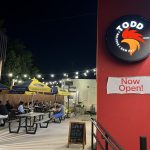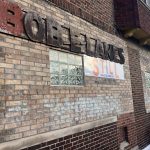Has Waze Wrecked Los Angeles?
All the city news you can use.
Want more links to read? Visit The Overhead Wire and signup. Every day at The Overhead Wire we sort through over 1,500 news items about cities and share the best ones with our email list. At the end of the week, we take some of the most popular stories and share them with Urban Milwaukee readers. They are national (or international) links, sometimes entertaining and sometimes absurd, but hopefully useful.
Vancouver Widens Its Sidewalks: As the city becomes denser, Vancouver BC planners and engineers are responding by expanding its sidewalks. In some areas, that means taking pavement away from cars, but elsewhere it means pushing buildings back. Builders aren’t complaining either; they get the same number of buildable square feet, whatever the setback, and the added trees and public furniture have made for more pleasant street life. The widenings have also been complemented with crosswalk and bike lane improvements. In the past 10 years, Vancouver has also created 100 curb bulges (where the curb extends into crosswalks), 10 raised crosswalks, and 730 intersections with countdown timers. (Frances Bula | The Globe and Mail)
Did Waze Hijack Los Angeles?: When Waze launched in 2011, Los Angeles went wild. For the first few years of its service, the app was lauded for its aggressive approach to navigation and the godly convenience of its algorithms. Nowadays, however, Angelenos are finding their residential streets turned into makeshift highways with much of the inconvenience occurring on narrow hillside streets. To save mere seconds or minutes on a commute, dozens of L.A. neighborhoods have become loud, exhaust-fumed, and gridlocked. Some residents have even turned to reporting fake accidents in their neighborhoods to redirect traffic. The chaos has triggered a debate on how tech companies’ navigation apps provide a false narrative of speed, and the inhuman use of data to send cars speeding through neighborhoods. (Jonathan Littman | Los Angeles Magazine)
Rethinking Public Consultation: Warren Logan, a Bay Area transportation planner, has ideas about how to truly engage diverse communities in city planning. There are many different populations, like people of color or those with disabilities, who are underrepresented at community meetings, but Logan is developing ways to get everyone in city policy-making. In an interview with CityLab, Logan discusses the nead for transit planners to listen to, instead of speak at, their constituents. His ideas include online engagement to increase outreach and holding small discussions, instead of just slideshows, at public open houses. Logan posits that instead of planners speaking of restrictions to their transit visions, it is crucial to be idealistic and discuss that vision, so that the public can think outside the box, generate their own ideas, and meaningfully participate in the planning process. (Sarah Holder | CItyLab)
Bringing Back the Idea of a Land Value Tax: The land value tax emerged in the 19th century, and was recently used to revive Millbourne, Pennsylvania after they fell into hard times from the loss of a Sears. The tax is intended to encourage landowners to make more productive use of large properties. A former car dealership and a bowling alley, the second and third largest parcels in the city, are now under development. The way tax policies are often organized simply encourages speculators to acquire and hold land until the right public-private partnership comes along. The land value tax was used in cities like Pittsburgh but was discontinued because of a failure to frequently reassess the land. Cities now compete against one another to lure big developers and businesses and collect tax revenue, but the tax incentives provided to do so take away funding from building and maintaining infrastructure. The land value tax can provide a more sustainable alternative. (J. Brian Charles | Governing)
Why We Should All Know Nipsey Hussle: On the intersection of Crenshaw and Slauson in South Los Angeles, Nipsey Hussle fought to claim place and space in a community rooted in decades of racist policies. Through multiple albums, nearly 50 singles, and a Grammy nomination, Hussle expressed the need for the community to claim what was theirs. From redlining to Boyz n the Hood to his modern discussions of law enforcement, Sahra Sulaiman breaks down Hussle’s legacy and his work to boost the morale of the black community in South LA. The city is committed to dismantling the Nipsey Hussle Tower commemorating his impact, but his spirit lives on in his community, even if not in material form. (Sahra Sulaiman | Streetsblog LA)
Quote of the Week
Finally, the bill perpetuates the false notion that highways are the most important transportation mode. In keeping with recent history, Congress has advanced a major highway bill before either of the Congressional committees dealing with rail and transit have even begun to act.
–Jenna Fortunati of Transportation for America discussing the worst parts of the current iteration of the next transportation bill.
This week on the podcast, Former Pasadena California Transportation Director Fred Dock comes on the show to talk about his career and the move from LOS to VMT.
Want more links to read? Visit The Overhead Wire and signup. (http://dtrnsfr.us/2iA8Yas)
Urban Reads
-
Congestion Pricing Cuts Air Pollution in New York City
 Dec 14th, 2025 by Jeff Wood
Dec 14th, 2025 by Jeff Wood
-
We Think We Love to Drive. But Do We Really?
 Dec 7th, 2025 by Jeff Wood
Dec 7th, 2025 by Jeff Wood
-
Can Scott Wiener Tackle America’s Housing Crisis?
 Nov 23rd, 2025 by Jeff Wood
Nov 23rd, 2025 by Jeff Wood






















